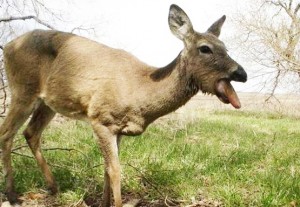- Deer infected with Epizootic Hemorrhagic Disease
(EDH)
Epizootic Hemorrhagic Disease also known as EDH or some other names such as bluetongue, blacktongue, blackleg, is an acute, infectious disease of white-tailed deer caused by the infection on a virus from the genus Orbivirus. EHD can be sometimes fatal. EHD is found through-out the United States and is spread from deer to deer. A majority of deer in the past have died from this vicious disease. EHD is spread by small biting flies in the genus Culicoides.
In 2013 there has been 7 deer diagnosed in 6 countries. Those deer were confirmed from a laboratory to be from Allegan, Ottawa, Oceana, Ionia, Berrien, and Muskegon. There has also been a few dead deer found having people curious about how it happened by possibly it being related to EHD. Illinois alone saw six cases of Epizootic Hemorrhagic Disease in the deer in the 2013 fall hunting season.
Hemorrhagic disease viruses are infectious to a wide range of wild animals. In addition to white-tailed deer, hemorrhagic disease has been found in mule deer, black-tailed deer, bighorn sheep, and pronghorn antelope. Infections in these wild animals have ranged from in apparent to episodes of high mortality. In the Southeast, slight infections in white-tailed deer are becoming more and mire common and are evidenced only by antibodies to the viruses in serum of normal, healthy deer. EHD and bluetongue viruses also infect domestic ruminants. Cattle and goats generally show no clinical illness or only mild disease when infected. In contrast, domestic sheep may develop severe illness when infected with bluetongue virus but apparently do not get sick when infected by EHD virus.
Humans are not at risk by touching infected deer, eating meat from an infected deer, or being bitten by infected . Deer that develop bacterial infections or abscesses secondary to hemorrhagic disease may not be suitable for consumption.
Some signs of the disease can be swelling from the head, neck, tongue, or eyelids. Also the deer could have difficulty breathing. Many infected deer appear normal or show only mild to no signs of illness. When illness occurs, the signs change as the disease progresses.
There is very few solutions that can be done to prevent or control hemorrhagic disease. The risk will be minimized in deer herds that do not exceed the carrying capacity of their habitat. The more the deer spread out and don’t come in contact with each other, the less that the disease will spread. This same concept holds true for most other diseases of whitetails. The best and only practical means of regulating deer is through properly managed sport hunting. Although the whitetails are all starting to die-off due to hemorrhagic disease often because an small emergency, past experiences have shown that mortality will not totally diminish local deer populations and that the outbreak will be curtailed by the onset of cold weather. Livestock and farm owners who suspect EHD or bluetongue virus infections should look for veterinary assistance to get diagnostic confirmation and supportive care for their animals as soon as possible just to be safe.
1. How can the deer get the disease but humans cant contract the virus?
2.Is their treatment for EHD?
3. Does EHD have a sex preference (male or female)?

After reading this article there wasn’t any surprises to me because I know all about this disease and how it works. I actually did my blog on the same thing and I know how this disease affects wildlife and how it is very harmful. Since I am a hunter I know a lot of things about deer and how this disease affects them. Something that I put on my blog that was missed was that they usually get really high fevers and go lay by some water or lay in the water and they pass out drowning themselves.
http://www.michigan.gov/dnr/0,1607,7-153-10370_12150-26647–,00.html
This article was very interesting because I didn’t even know deer’s could have this kind of disease. I think humans can’t get the virus because our immune systems, depending how strong they are, can fight this off easily. There really is no treatment for this virus but you can get a vaccine to help. No it does not, also it does not spread from one dear to the next is has to go through the insect vector to pass on. There have been many reports from this disease in the north American area. The deer’s get this from getting bit by Culicoides biting fly or midge.
http://www.michigan.gov/dnr/0,1607,7-153-10370_12150-26647–,00.html